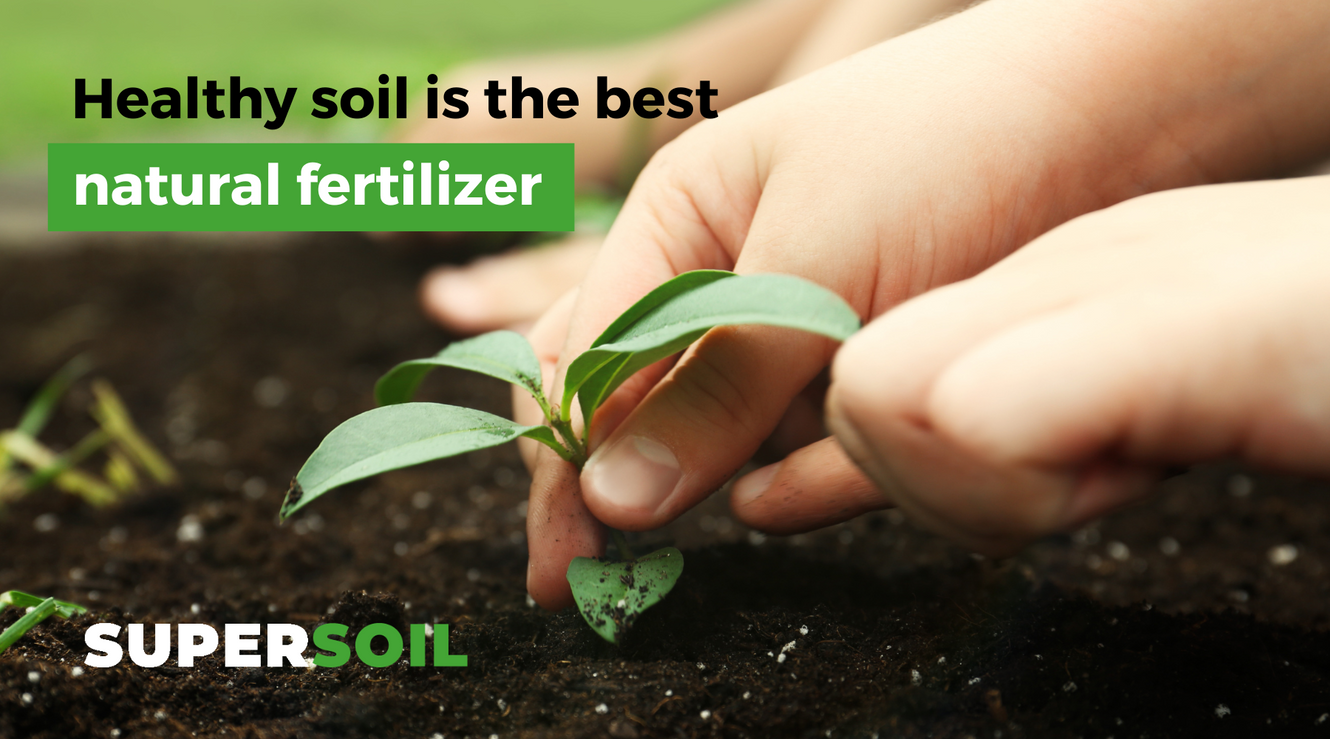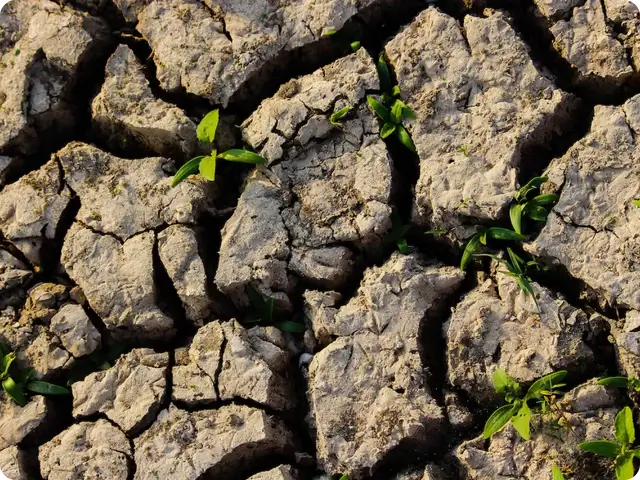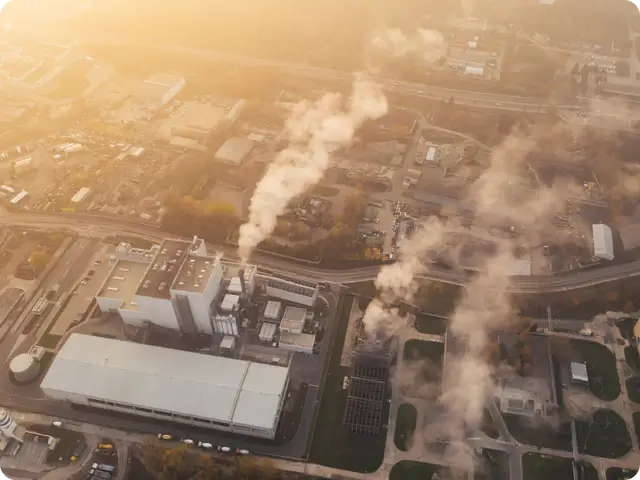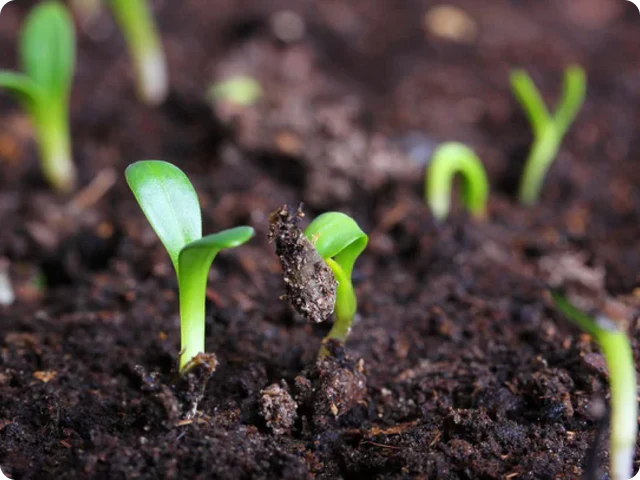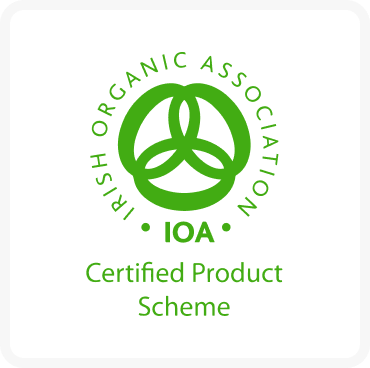Healthy soil is by far the best natural fertilizer, a concept lost in modern agriculture and gardening practices. Healthy soil is how our amazing plant diversity fed humanity for millennia long before conventional agriculture.
We will explain what this means and show you how you can create your own natural organic fertilizer. Let’s dive in!
What is Soil?
By definition, soil contains minerals (aka dirt), organic matter, living organisms, and some air and water in the pore spaces. This means real soil is much more than minerals, air, and water; soil is dirt plus life and death.
This definition of soil and the whole food-nutrient cycle on our planet, where to grow nutritious food, we must return nutrients to the soil, are concepts that conventional agriculture misses completely. Conventional agriculture is actually better called chemical farming since, by convention, we used to farm organically and regeneratively until about the 1940s. Furthermore, chemical farming sees dirt as a medium, not a source of nutrients, and it sees plants as needing constant chemical fixes. It feeds (not nourishes) the plants with chemicals; they grow, and then we remove them. We add no organic matter back to the soil, add more synthetic nitrogen, disrupt the global nitrogen cycle and contribute to climate change, grow another crop, and repeat that cycle. Meanwhile, whatever organic matter was in that soil has disappeared, and the soil is either dead or dying. It is no longer soil; it is mineral dirt that erodes away on a massive scale. Any plants we grow on it are weak and prone to pests and disease because they have no soil nutrients, no immune system, and are chemically dependent.
The Problem With Synthetic Nitrogen
There are numerous problems with synthetic nitrogen. It requires enormous amounts of fossil fuels to create, contributing to climate change. Then, when we apply it to our fields, it is responsible for up to 73% of human sources of nitrous oxides in our atmosphere, a greenhouse gas at least 265 times more potent than carbon dioxide.
There are also other serious concerns. One significant one is that it doesn't stay where we put it. This is because most stable soil nitrogen comes in organic form from microbial necromass - the decaying bodies of microbes. That microbial necromass is also the glue that helps hold nutrients in our soil. Therefore, without that glue, conventional nitrogen fertilizers leach from the soil every time it rains, or we irrigate our crops, and we just have to apply more in a vicious, destructive cycle. When it runs off our fields, it also pollutes our water supplies, causing numerous serious health problems worldwide, even at levels below what is considered safe.
The Problem With Mineral Phosphorus
Phosphorus is even more limiting in natural ecosystems than nitrogen is, so we use mineral phosphorus fertilizers derived from rocks. The problem with mineral phosphorus is that about 70% of what we apply is not even used by our crops because it is in ‘legacy phosphorus’ form that becomes locked in the minerals and unavailable to crops. Another small but extremely significant amount runs off. Between that and our non-utilization of crop and food wastes being returned back to the soil, about 95% of our very limited supply of phosphorus is lost due to our inefficiencies. Furthermore, using mineral phosphorus also increases heavy metals (cadmium, uranium, lead, mercury) in our soils and crops, and it causes imbalances that result in soil degradation and acidification.
Unfortunately, because phosphorus is so limiting in ecosystems, when that small percentage runs off into our waters, it causes algae blooms in lakes and oceans, destroying our aquatic ecosystems worldwide. Look at any lake in the prairies: green, smelly, and void of healthy aquatic life, or the algae and seaweed blooms polluting our beaches and choking out coastal marine life.
When we farm conventionally and don’t compost, we waste a lot of phosphorus in manure, crop residues, and food waste later down the value chain. To reduce our dependence on limited supplies of mineral phosphorus, save our aquatic ecosystems, and ensure a good supply of phosphorus for future generations, we need to add organic matter back to the soil to supply the necessary phosphorus. Furthermore, because the microbes break down the organic matter and release phosphorus more slowly than when we add mineral phosphorus, this regenerative farming technique does not cause water pollution like mineral phosphorus.
Healthy Soil is the Best Fertilizer for Plants
Instead of mineral dirt, real soil is where death becomes life because the decaying bodies of microbes and other once-living components break down and feed your plants, nourishing the next generation the way nature did before conventional agriculture was invented.
Since it is the bodies of microbes that account for about 50-80% of our soil organic carbon and about 40-90% of our soil nitrogen stores, it makes sense that to make the best fertilizer for farming, all you need to do is nourish your soils and grow a healthy microbe population. Microbes live and die in the order of hours, with many generations growing and dying daily. Nourished compost-rich soil nurtures our plants with microbes, organic nitrogen, and organic phosphorus. Soil, real soil full of life and death, becomes the perfect natural fertilizer for plants. Who would have thought nature already knew best?
A Better Fertilizer For Farmers To Make Farming Profitable Again
Instead of paying chemical companies to degrade your soil, pollute your water, and create weak, chemically dependent plants, you can add compost and microbes and regenerate your soil. When you feed your soil, you develop a healthy soil biome filled with nutrients. Then, your soil will become your best fertilizer for farming, feeding your plants the way it always did for countless millennia before conventional agriculture was invented.
According to the USDA, combined crop inputs (chemicals, fertilizers, and seeds) are $56.4 billion annually in the USA, about 28.9% of crop farms' total expenses, with seeds being only a small fraction of that total. Interestingly, the US government also spends billions yearly, about $15.6 Billion USD just in 2022, in direct farm subsidies, which overwhelmingly are given to corporate farms using chemical agriculture to grow soy, corn, and wheat. This means that chemical farming is being subsidized by their citizens to make it profitable, all while also destroying the soil, polluting the water, worsening climate change, and filling the pockets of chemical companies instead of farmers.
Farmers can break this cycle and reduce or even eliminate chemical bills altogether. All you need to do is stop using all those chemicals and spend a tiny fraction of that amount on compost and microbes to nourish the soil. Then, farming would become profitable for farmers again.
Supersoil - The Liquid Fertilizer That Makes Sense And Money
Supersoil’s unique blend of microbes is easy to add to your soil or existing crops. Simply mix it with water and apply it as a liquid fertilizer. Nothing could be easier. Of course, if your soil is dying or dead, you should also add some organic matter in the form of compost to aid in regenerating your soil.
Every 1 kg pouch of Supersoil contains the equivalent of 20 tonnes of organic matter and trillions of microbes. It creates a population explosion of microbes that will grow and die, many generations every single day. They will nourish your soil and, in turn, become the best fertilizer for plants that money can buy. All for only a tiny fraction of the cost that chemicals are costing you now.
Other Benefits of Using Your Soil as a Natural Fertilizer
In addition to stopping the chemical pollution of our soils, air, and water and making farming profitable for farmers again, there are other benefits. One is retaining and regenerating our topsoil. We have already lost ⅓ of our global topsoil; at that rate, we may lose it all in the next 60 years if we do not switch to regenerative rather than degenerative farming. Microbial necromass is the glue that holds our soils together so it doesn’t erode away. Therefore, we can use compost and microbes to stop erosion and regenerate all we have lost. It really is that easy.
Healthy soils are also incredibly rich in organic carbon, which means that healthy soils filled with organic carbon become a massive sink for carbon dioxide, a greenhouse gas causing much of our current climate troubles.
Finally, healthy soils create healthy plants that are far better able to resist pests and disease. Ironically, pesticide-treated plants have many times more pests than those grown on regeneratively farmed fields. This means that you can reduce or eliminate your pesticide and herbicide bills as well, with all the benefits that will bring.
With all the benefits of creating healthy soil to use as a natural organic fertilizer, why not make the switch? You won’t be disappointed!
References
Buckeridge, K. M., Mason, K. E., McNamara, N. P., Ostle, N., Puissant, J., Goodall, T., Griffiths, R. I., Stott, A. W., & Whitaker, J. (2020). Environmental and microbial controls on microbial necromass recycling, an important precursor for soil carbon stabilization. Communications Earth & Environment, 1(1), 1-9. https://doi.org/10.1038/s43247-020-00031-4
Farm Production Expenditures 2020 Summary. (2021). https://www.nass.usda.gov/Publications/Todays_Reports/reports/fpex0721.pdf
Green America. (n.d.). Www.greenamerica.org. Retrieved May 19, 2024, from https://www.greenamerica.org/soil-not-oil-how-organics-can-feed-world/living-soil-vs-dead-dirt
Tully, K., & Ryals, R. (2017). Nutrient cycling in agroecosystems: Balancing food and environmental objectives. Agroecology and Sustainable Food Systems, 41(7), 761–798. https://doi.org/10.1080/21683565.2017.1336149
US Agriculture Statistics and Data Trends. (2023, February 24). USAFacts. https://usafacts.org/topics/agriculture/
Walsh, M., Schenk, G., & Schmidt, S. (2023). Realising the circular phosphorus economy delivers for sustainable development goals. Npj Sustainable Agriculture, 1(1), 1-15. https://doi.org/10.1038/s44264-023-00002-0
Ward, M. H., Jones, R. R., Brender, J. D., Weyer, P. J., Nolan, B. T., & Villanueva, C. M. (2018). Drinking Water Nitrate and Human Health: An Updated Review. International Journal of Environmental Research and Public Health, 15(7). https://doi.org/10.3390/ijerph15071557

